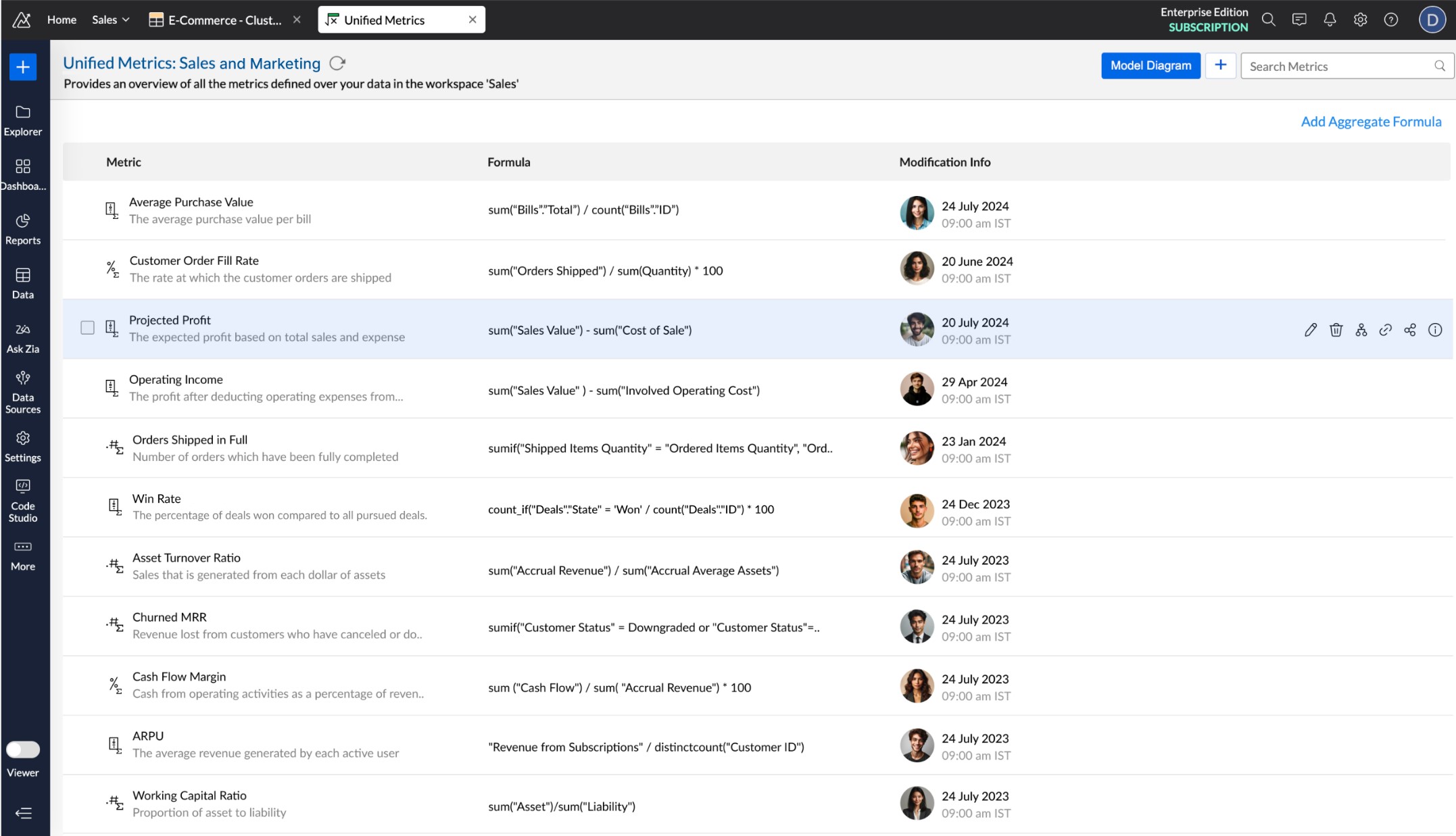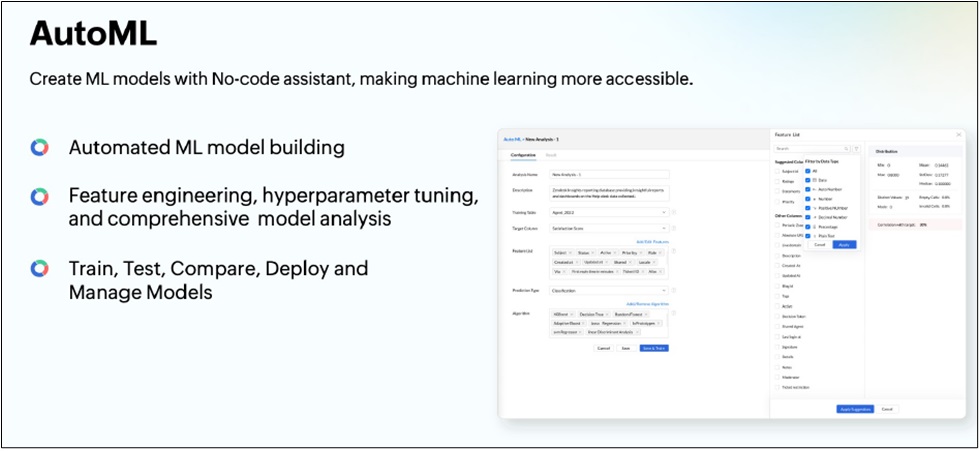Zoho Analytics 6.0 brings AI-infused upgrades to data management, natural-language interaction, and data science capabilities – all at superow prices.
Zoho is not just a cost-competitive disrupter in the CRM, personal productivity, and collaboration spaces; since 2009 the company also has been steadily gaining market share in the business intelligence (BI) and analytics arena. Zoho Analytics 6.0, the latest upgrade of the vendor’s BI and analytics platform, announced on September 12, ups the ante by adding advanced, artificial intelligence (AI)-powered capabilities for data management, natural-language (NL) interaction, and data science. Although some of the tools are aimed at data professionals, they’re integrated with a platform that brings the power of insight, prediction and action back to ordinary business users.
There’s no doubt that competitive pricing has a lot to do with Zoho Analytics’ adoption by more than 17,000 organizations and three million users. What buyer would not at least consider a BI and analytics platform with all-inclusive pricing that comes in at less than $10 per user, per month (based on the annual pricing of Zoho Analytics Enterprise)? That does not mean that customers must sacrifice much when it comes to functionality. Zoho stays competitive with state-of-the-industry features, as plified by the three Zoho Analytics 6.0 upgrade themes detailed below.
Going Deeper on Data Integration and Data Management
To recap some of the basics of Zoho Analytics, the platform is most often purchased as a multitenant software-as-a-service (SaaS) offering that runs on Zoho Cloud, which operates 16 data centers around the globe, with redundant data centers in North America, Europe, India, China, Japan, Saudi Arabia, and Australia. Zoho Cloud has stringent, transparent privacy policies and meets compliance requirements in multiple countries and jurisdictions (including the California Consumer Privacy Act in the U.S. and the General Data Protection Regulation in Europe).
Zoho Analytics is also available as a server-based offering deployable through the Amazon Web Services (AWS) and Microsoft Azure marketplaces or by customers themselves on other public clouds or on private clouds.
Where data integration and data management are concerned, Zoho Analytics offers out-of-the-box connections with more than 500 data sources, including cloud and on-premises databases, popular productivity tools and business applications, files, feeds, and spreadsheets. Zoho DataPrep, included with Zoho Analytics Enterprise, supports automated data modeling and blending, smart (augmented) data cleansing, no-code data transformation, data enrichment, and data cataloging.

Zoho Analytics 6.0 upgrades include new data modeling capabilities and a metrics store, above, that helps ensure consistency and promote reuse of approved metrics and measures.
Zoho Analytics 6.0 enhances the platform’s data integration and data management capabilities by offering the following:
- New data connectors, including streaming options. The pace of business is always accelerating, so Zoho has added pre-built connectors for popular streaming sources Google Cloud Pub/Sub, Kafka and the PubNub platform for real-time applications. Among the 25 other new connectors added with version 6.0 are app integrations with Oracle NetSuite, Expensify, and Monday.com, and data source integrations with Databricks, Google Cloud Storage, Neo4J, and Yellowbrick.
- Ask Zia NL assistance within Zoho DataPrep. In the 6.0 release, Ask Zia, Zoho’s NL copilot, has been added to Zoho DataPrep. Users can now simply ask it to “remove duplicates” or “join two datasets,” for example, to clean up or enrich data.
- New metrics layer. Semantic modeling capabilities help to ensure data consistency, reliability, and reusability, so Zoho is stepping up on this front in Zoho Analytics 6.0 by adding data modeling capabilities, a metrics store, and deeper access control capabilities. The upgrade will make it easier to provide and secure consistent data and to standardize and reuse key performance measures.
- Zoho Flow integration. The vendor has integrated Zoho Data Prep with Zoho Flow, the vendor’s lightweight workflow engine, providing an (extra-cost) option to meet more sophisticated data pipelining and data orchestration requirements.
Infusing AI Across the Platform
Generative AI (GenAI) continues to grab lots of attention, but it’s not the only form of AI that’s driving innovation. Zoho is infusing a variety of AI capabilities into Zoho Analytics to speed analysis and derive deeper insights:
- Zia Insights gets diagnostic. Zia Insights is an existing AI/machine learning (ML)-powered automated insights feature that helps users spot variances, outliers, and trends; do comparative analysis; and get top insights through NL explanations. In the 6.0 release, Zia Insights gains diagnostic capabilities for root-cause analysis. This helps to answer the “why” questions, explaining with short NL narratives the key drivers behind changes in any measure or key performance indicator (KPI).
- Ask Zia adds actions, languages and integrations. As of the 6.0 release, Ask Zia can handle complex calculations and trigger actions. For example, you can Ask Zia to create a new calculated field, generate a new report containing that field, and then send a PDF copy of the resulting report to specific users or groups. Ask Zia is also now multilingual, understanding and generating French and Spanish as well as English. Finally, the Ask Zia Bot can now be integrated with collaboration/messaging platforms such as Microsoft Teams, bringing NL analysis capabilities outside of the context of reports and dashboards.
- Auto Analysis generates high-value reports and dashboards. Now that Zoho Analytics has a metrics layer, the platform’s augmented Auto Analysis feature has been enhanced to automatically generate metrics, reports and dashboards. With the click of a button, Auto Analysis can generate dashboards focusing on, for example, sales analysis, net revenue analysis, ad spend, or sales versus net spend. In case the results don’t quite fit the needs of the organization, customization features are available to tweak the automated output.
- Open AI integration. Zoho Analytics’ bring-your-own-key (BYOK) integration with Open AI has been enhanced to provide contextual assistance for SQL query creation, metrics generation, and data-enrichment using public datasets. The integration also now supports retrieval augmented generation (RAG) against customer data without data sharing. To ensure security and privacy, only underlying metadata is shared with OpenAI.
Supporting Data Science and Machine Learning
Many organizations want to go beyond descriptive and diagnostic analytics – rearview analysis of what happened and why. They want to graduate to predictive and prescriptive analytics – gaining insight into what will happen and what should be done about it. Following this interest, many BI and analytics vendors are moving into the predictive domain.
in the 6.0 release, Zoho is adding a new DSML Studio supporting-- you guessed it--data science and machine learning. DSML Studio is aimed at data scientists, data engineers and savvy data analysts, but once their data transformation and modeling work is done, the resulting predictive results can be shared with the broad base of ordinary business users through reports, dashboards, key metrics and so on. Salespeople, for example, could be exposed to leads predicted to be most likely to convert, and service agents could see if customers they are busy supporting are likely to churn.

Zoho Analytics’ new DSML Studio and its AutoML feature help customers go beyond descriptive and diagnostic analytics and move into the predictive realm.
- AutoML. DSML Studio’s AutoML feature draws from an assortment of pre-built algorithms – XGBoost, decision tree, random forest, adaptive boost, linear regression and so on – and automates feature selection, model selection, and hyperparameter tuning based on the selected data and type of prediction desired. The feature also supports testing, deployment, and management of resulting models.
- Code Studio. Aimed more squarely at data scientists, DSML Studio’s Code Studio component is an integrated Python environment for custom model development.
Constellation’s Analysis
There’s more to the Zoho Analytics 6.0 upgrade, including analytic portal integration with Tableau and Power BI, but the overarching theme is adding more features, more AI/ML/GenAI capabilities, and more value to an already competitive platform.
As I detailed in my in-depth analysis of Zoho Analytics, among Zoho Analytics’ few weaknesses are the fact that it’s available as a service only on Zoho Cloud. That’s not a concern for customers using other Zoho apps that also run on Zoho Cloud, but customers with data concentrated on AWS, Azure, or Google Cloud have a choice: either live with cloud data connections (and their potential latency) or self-manage Zoho Analytics on a third-party cloud. One other drawback: Zoho Analytics is a view-only system lacking write-back capabilities, a drawback in certain embedded scenarios where interactivity with parent applications is desirable.
Again, Zoho Analytics’ greatest strength is the value that it offers for very little money. There are entry-level price points, but the buying option that makes sense for any organization with more than 100 employees is Zoho Analytics Enterprise, which starts at $455 per month for 50 users, based on an annual subscription. Best of all, the Enterprise package includes everything, including Zoho Data Prep; Zia Insights; Ask Zia; Auto Analysis; DSML Studio; the analytic portal; and higher-level allowances for data connectors, storage, data refreshes, alerts, scheduled report delivery, and more.
One last point I’ll make is about the Zoho Analytics support experience, which is “fantastic,” according to customer Kris James of Sparex. That’s not something I’m used to hearing from a lot of BI and analytics customers.


